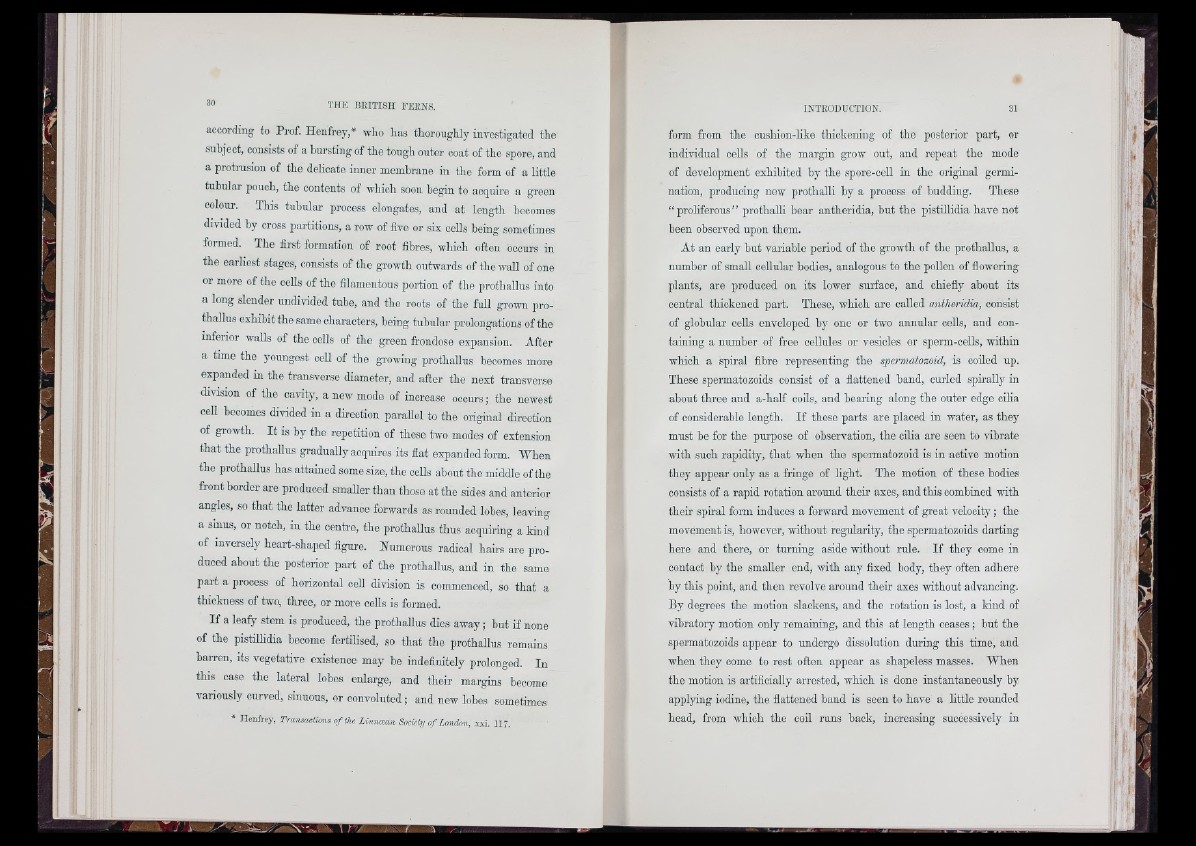
according to Prof. Ilenfrey,* who has thoroughly investigated the
subject, consists of a bursting of the tough outer coat of the spore, and
a protrusion of the delicate inner membrane in the form of a little
tubular pouch, tho contents of which soon begin to acquire a green
colour. This tubular process elongates, and at length becomes
divided by cross partitions, a row of five or six cells being sometimes
formod. The first formation of root fibres, which often occurs in
the earliest stages, consists of the growth outwards of the wall of one
or more of the cells of the filamentous portion of tho prothallus into
a long slender undivided tube, and the roots of the fuU grown prothallus
exhibit the same characters, being tubular prolongations of the
inferior walls of the cells of the green frondose expansion. After
a time the youngest cell of the growing prothallus becomes more
expanded in the transverse diameter, and after the next transverse
division of the cavity, a new mode of increase occurs; the newest
cell becomes divided in a direction paraUel to the original direction
of growth. I t is by the repetition of these two modes of extension
that the prothallus gradually acquires its flat expanded form. When
the prothallus has attained some size, the cells about the middle of the
front border are produced smaller than those at the sides and anterior
angles, so that the latter advance forwards as rounded lobes, leaving
a smus, or notch, in the centre, the prothallus thus acquiring a kind
of inversely heart-shaped figure. Numerous radical hairs are produced
about the posterior part of the prothallus, and in the same
part a process of horizontal cell division is commenced, so that a
thickness of two, three, or more cells is formed.
I f a leafy stem is produced, the prothallus dies away; but if none
of the pistfflidia become fertilised, so that the prothallus remains
barren, its vegetative existence may be indefinitely prolonged. In
this case the lateral lobes enlarge, and their margins become
variously curved, sinuous, or convoluted; and new lobes sometimes
* Henfroy, Transactions o f the Lmnmmi Society o f London; xxi. 117.
form from the cushion-like thickening of the posterior part, or
individual cells of the margin grow out, and repeat the mode
of development exhibited by the spore-cell in the original germination,
producing new prothalU by a process of budding. These
“ proliferous” prothalli boar antheridia, but the pistillidia have not
been observed upon them.
At an early but variable period of tho growth of tho prothallus, a
number of small cellular bodies, analogous to the pollen of flowering
plants, are produced on its lower surface, and chiefly about its
central thickened part. These, which are called antheridia, consist
of globular cells enveloped hy one or two annular cells, and containing
a number of free cellules or vesicles or sperm-oolls, within
which a spiral fibre representing the spermatozoid, is coiled up.
These spermatozoids consist of a flattened band, curled spirally in
about three and a-half coils, and hearing along the outer edge cilia
of considerable length. I f these parts are placed in water, as they
must he for the purpose of observation, the cilia are seen to vibrate
with such rapidity, that when the spermatozoid is in active motion
they appear only as a fringe of light. The motion of these bodies
consists of a rapid rotation around their axes, and this combined with
thoir spiral form induces a forward movement of great velocity; the
movement is, however, without regularity, the spermatozoids darting
here and there, or turning aside without rule. I f they come in
contact by the smaller end, with any fixed body, they often adhere
by this point, and then revolve around thoir axes without advancing.
By degrees the motion slackens, and the rotation is lost, a land of
vibratory motion only remaining, and this at length ceases; but the
spermatozoids appear to undergo dissolution during this time, and
when they come to rest often appear as shapeless masses. When
the motion is artificially arrested, which is done instantaneously by
applying iodine, the flattened band is seen to have a little rounded
head, from which the coil runs back, increasing successively in